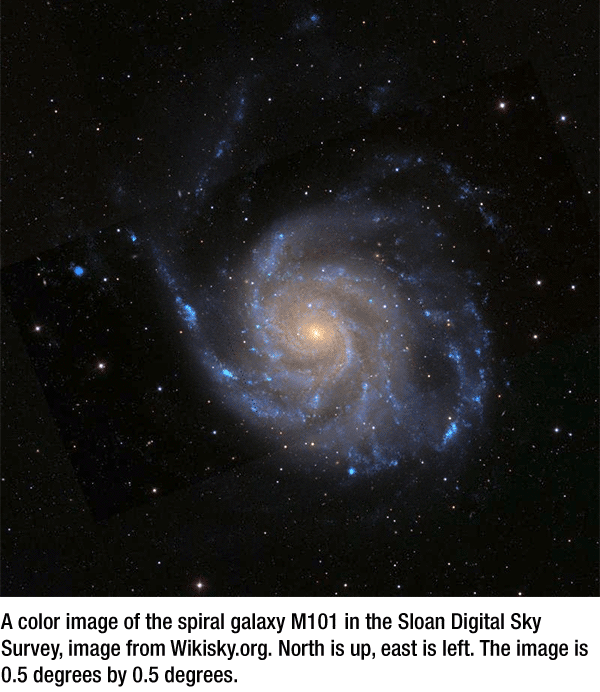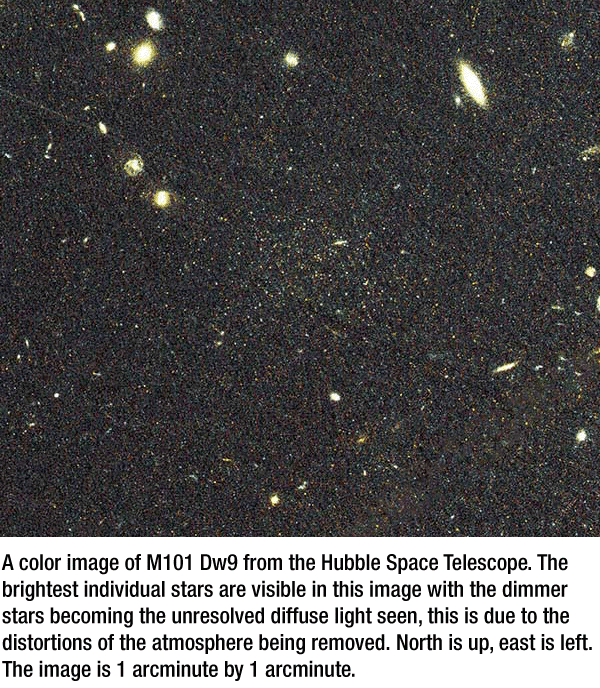Leading the Way

Paul Bennet, a doctoral student in the Department of Physics & Astronomy, will be using the Hubble Space Telescope to research the spiral galaxy M101, depicted in the background. M101 image is from the Sloan Digital Sky Survey, courtesy of Wikisky.org.
PhD Student Paul Bennet Will Use Hubble Space Telescope to Compare Galaxies
Written 10.1.2019 by Glenys Young
Is the Milky Way unusual among spiral galaxies?
It's a big question—one with many smaller questions that stem from it, and one that Texas Tech University's Paul Bennet is looking to answer. Thanks to the Space Telescope Science Institute, he'll soon be better equipped to do so.
The institute recently awarded Bennet, a doctoral student in the Department of Physics & Astronomy, observing time on the Hubble Space Telescope. His research, which will last through Sept. 30, 2020, will attempt to confirm the presence of four dwarf galaxies near the spiral galaxy M101 as a first step in comparing M101 with our own galaxy, the Milky Way.
The award of Hubble observing time is an exceptional accomplishment, as it carries both the opportunity for scientific discovery and funding to ensure awardees can analyze and share their data with the scientific community, students and the general public. Out of 3,592 proposals submitted for the upcoming observation cycle—by investigators in 40 countries, 47 U.S. states, the District of Columbia and the U.S. Virgin Islands—only 182 were selected to receive observation time. Bennet's award was one of seven in Texas.
Bennet's Research
M101 is a spiral galaxy about 20 million light-years from Earth. It's similar to the Milky Way in mass and radius, but previous work has shown that M101 has far fewer dwarf galaxies surrounding it than the Milky Way.

The four dwarf galaxies Bennet is looking for were found previously in images from the Canada-France-Hawaii telescope on Mauna Kea, Hawaii, as part of a project to find Low Surface Brightness (LSB) objects around M101. LSB objects are astronomical objects that are dimmer than the night sky; this means they're difficult to detect, but scientists can do so, thanks to advances in software and telescopes. These dwarf galaxies, if that's what they are confirmed to be, would comprise the first example of an Ultra-Faint Dwarf (UFD) regime outside of the Milky Way or our neighboring Andromeda galaxy.
UFDs' brightnesses are so low that they weren't detected around the Milky Way until the early 2000s, and they were only detected around Andromeda in 2014. If these four objects are confirmed to be UFDs, they would present a new opportunity for comparison between the Milky Way, Andromeda and M101.
But to make that comparison, Bennet first must establish that the objects really are UFDs near M101. That means he needs to determine the distance to them.
"In general, looking at the sky gives 2D information as to where an object is—you can get the position but not the distance from Earth," he explained. "This makes drawing conclusions about whether two objects are associated very difficult, particularly in extra-galactic astronomy, as they may look close to each other but are actually separated by millions of light-years in distance. We can, however, use the individual stars in a distant galaxy to work out how far away it is, because some stars have a set brightness. We can use how bright they appear to us and the knowledge of the set brightness to work out a distance.
"These galaxies are far enough away that observations from space are required to pick out the individual stars, which is why we are using the Hubble Space Telescope. We can then use this distance information to confirm if these objects are close to M101 or if they merely look close."
Bigger Question
Bennet says comparing the Milky Way to other galaxies is quite important to accurately understand the universe as a whole.
 "A lot of our current understanding of the universe comes from studying the Milky
Way and the smaller dwarf galaxies that orbit it," he said. "However, we don't know
if the Milky Way is actually a good example of a 'typical' spiral galaxy or if it
is unusual in some way.
"A lot of our current understanding of the universe comes from studying the Milky
Way and the smaller dwarf galaxies that orbit it," he said. "However, we don't know
if the Milky Way is actually a good example of a 'typical' spiral galaxy or if it
is unusual in some way.
"It is always dangerous in science to draw large conclusions with only a single data point. For example, it was previously thought that our solar system was typical, but as we have discovered more and more exoplanets, we have found that there are many different types of solar systems, and our own is actually unusual."
Bennet says examining these four objects can help answer that question, at least partially. This research, then, represents the first step in a much deeper, future comparison of the Milky Way and other spiral galaxies.
It's a project Bennet is looking forward to undertaking, particularly because the opportunity to do so is rare. According to Sung-Won Lee, professor and chair of the Department of Physics & Astronomy, Bennet is the first Texas Tech graduate student to be awarded Hubble observation time as a principal investigator.
"Very few doctoral students get awarded Hubble Space Telescope time," Lee said. "Most professional astronomers never get Hubble data. But because of Paul's unique algorithm, he has excelled at the highest levels."
College of Arts & Sciences
-
Address
Texas Tech University, Box 41034, Lubbock, TX 79409-1034 -
Phone
806.742.3831 -
Email
arts-and-sciences@ttu.edu
